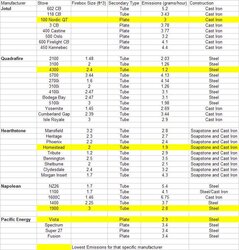Just as the topic says, I know some stoves like Pacific Energy use a solid top baffle with holes drilled in it to supply secondary combustion air, whereas stoves like quadrafire and some jotul models just a stainless tubular manifold, usually fed by a series of rectangular tubes.
I know that representations of each are owned by several members on the board, any opinions? Any feelings on which is better? Someone with experience with both tops would be great I have my own feelings, but I want to know what the consensus is amongst those who actually know what they're talking about.
I have my own feelings, but I want to know what the consensus is amongst those who actually know what they're talking about.
Thanks in advance
I know that representations of each are owned by several members on the board, any opinions? Any feelings on which is better? Someone with experience with both tops would be great
 I have my own feelings, but I want to know what the consensus is amongst those who actually know what they're talking about.
I have my own feelings, but I want to know what the consensus is amongst those who actually know what they're talking about.Thanks in advance


